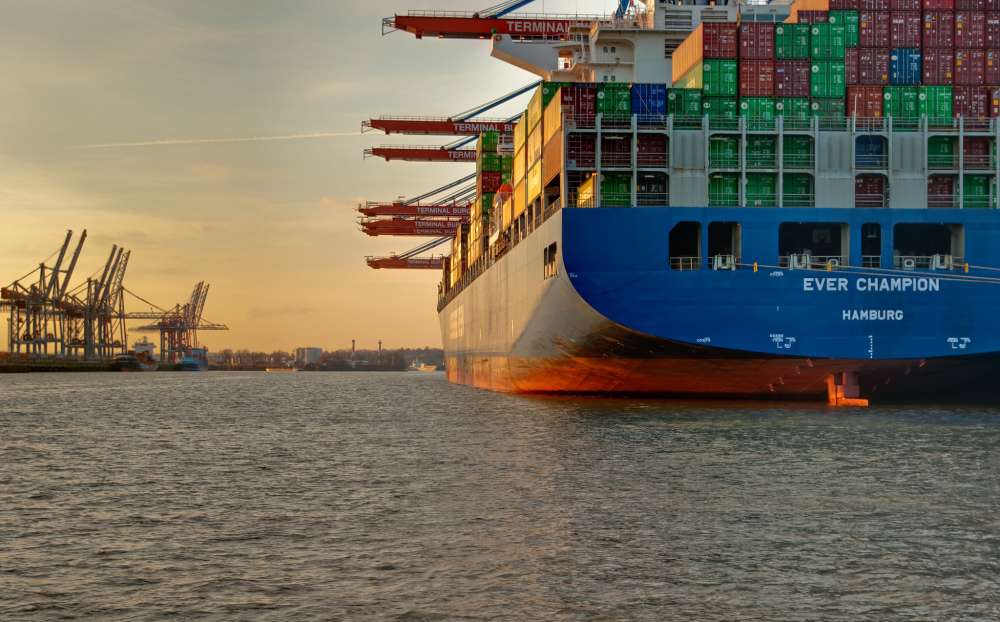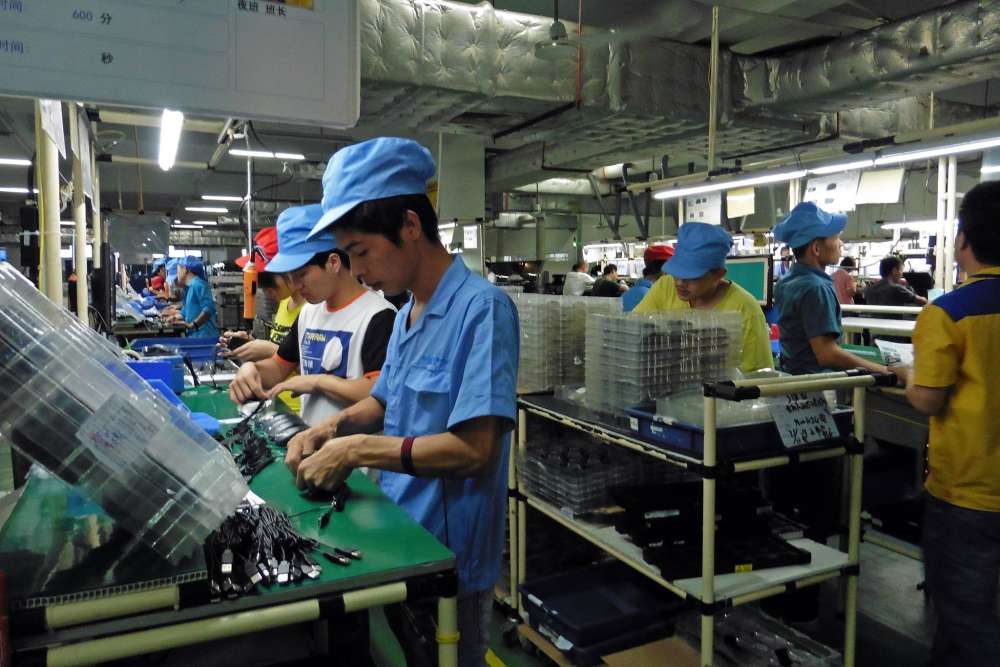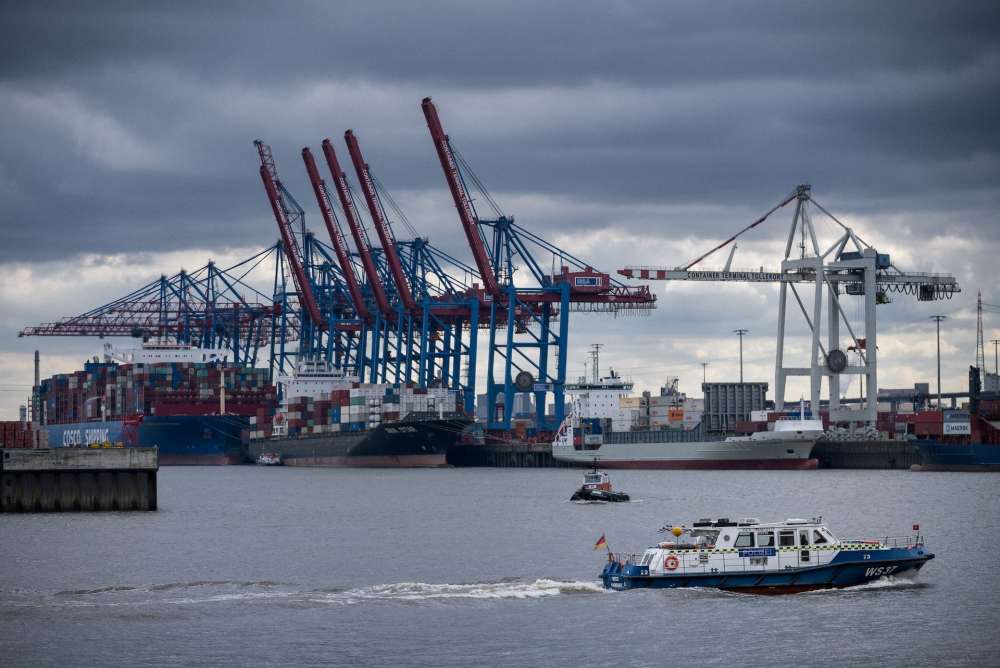Finding a New Compass for Germany’s Foreign Economic Policy

(Jens Auer /Flickr)
Germany has one of the most internationalized economies in the world. This comes with benefits, but also with risks. Berlin’s new national security strategy is an opportunity to recalibrate its foreign economic policy to pursue a holistic mix of partnerships to better maneuver the changing geopolitical environment.
Just-in-time deliveries, cost savings through concentration and eliminating redundancies, supplier and production hubs – the past decades have been characterized by a strong internalization and rationalization of value chains, resulting in enormous efficiency gains. Both producers and consumers have benefited massively from these developments: a wider variety of cheaper products with faster delivery times as well as more and better-paying jobs. This has been especially true for Germany, which is one of the most globalized countries in the world. However, the consequences of Russia’s war on Ukraine, China’s increasingly aggressive stance internationally, disruptions caused by the COVID-19 pandemic, and the trade war between the United States and China under former US President Donald Trump have made painfully clear the danger of becoming too dependent on individual countries, suppliers and production hubs. Given the changing geopolitical environment, it is high time to recalibrate foreign economic policy and include external costs not only for environmental and social issues, but also for security in trade, investment, sourcing, and sales decisions.
Germany’s Dependence on International Markets
Germany is more dependent on the global economy than almost any other industrialized nation. With a foreign trade ratio of 89.4 percent in 2021, Germany’s economy is the most “open” and thus the most internationalized economy in world trade among the G7 countries. Germany has lived up to its reputation as an export nation: in 2020, it was the world’s third largest exporter after the United States and China. The growing importance of exports for Germany is also reflected in the contribution of net exports to the country’s gross domestic product (GDP). Whereas this number stood at 0.2 percent in 2000, it rose to 5.5 percent by 2021. In addition, Germany has a massive current account surplus, amounting to 7.5 percent of its GDP in 2021.
The German labor market is also heavily dependent on exports. Around 27 percent of jobs in Germany are directly or indirectly related to exports – in the manufacturing sector, the figure is as high as 56 percent. In 2021, China was once again Germany’s most important trading partner – now for the sixth time in a row. According to preliminary results from the German Federal Statistical Office, Germany and China traded goods worth 245.7 billion euros over the year. The Netherlands and the United States followed in second and third place in their trade with China, with 206 and 194.1 billion euros, respectively. Nevertheless, the EU remains Germany’s most important market. Germany’s share of exports and imports to the EU in 2021 stood at 51 percent and 53.5 percent, respectively.
Vulnerabilities in Trade
In itself, trade is not a vulnerability, but a strength: it forms a crucial pillar of economic growth, income and job creation. However, trade can also lead to vulnerabilities if states are too dependent on individual countries and suppliers. These dependencies leave countries vulnerable to supply shocks, which can have many different causes, such as natural catastrophes (floods, storms, earthquakes, droughts, wildfires, etc.), shipping accidents, political interventions, conflicts and wars, cyber-attacks, as well as pandemics. This holds true for both the sourcing of inputs for production and sales markets.
In 2021, the European Commission published a report that maps out the EU’s dependence on certain materials and products which are deemed critical, covering six areas: raw materials, active pharmaceutical ingredients, li-ion batteries, clean hydrogen, semiconductors, as well as cloud and edge services. The report was updated in 2022. Within its criticality and dependence analysis, the Commission analyzed both demand and supply, taking into consideration, for example, increasing demand due to the digital revolution and green transition in the EU. Analyzing more than 5,000 commodities, the 2021 report identified 137 products in the most sensitive ecosystems which make up about 6 percent of the extra-EU import value of goods. The report’s finding: China (representing about half of import value), Vietnam and Brazil are the most important origins of EU import value for these products.
» Trade forms a crucial pillar of economic growth, income and job creation – but it can also lead to vulnerabilities if states are too dependent on individual countries and suppliers. «
Raw materials are particularly critical. The EU regularly publishes a list of critical raw materials, which are characterized by a high degree of sourcing concentration (in some cases due to geological factors, in others because of market interventions by the extracting and/or refining countries) and high usage in industrial value chains. These critical raw materials, such as lithium, cobalt, palladium, and rare earth elements (REEs), are indispensable for the EU’s digitalization and green transition. A few examples illustrate the EU’s vulnerability to supply chain disruptions. For example, China supplied 86 percent of the world’s rare earth in 2020 according to the European Commission. Among other applications, rare earth elements are used in rechargeable batteries for electric and hybrid cars, computers, superconductors, wind turbines, and catalysts in cars. Around 98 percent of the EU’s annual rare earth supply was imported from China. The need for such materials is only growing: for example, according to the European Commission, the EU demand for rare earth materials used in permanent magnets (for example, for electric vehicles, digital technologies and wind generators) could increase tenfold by 2050. To add to this, the list of raw materials with high import-dependence and concentration is long: for example, in 2020, the EU imported 93 percent of its magnesium from China, 98 percent of its borates from Turkey and 85 percent of its niobium from Brazil. By 2050, European demand for lithium is likely to be almost 60 times higher than current consumption. In 2020, 78 percent of the EU’s lithium supply was imported from Chile. Russia accounted for 40 percent of global supply of palladium in 2020, which is an important component of catalytic converters. The country had historically been a major supplier to the European market: Russia’s war on Ukraine massively disrupted the supply of palladium and underlined the EU’s vulnerability.
Another critical area of European trade is semiconductors, which are indispensable in industrial value chains such as for automated cars, the Internet of Things, supercomputers, and defense technologies. However, not a single European company is present among the top 15 semiconductor providers worldwide (by overall turnover), according to a ranking by Technik+Einkauf. The world semiconductor market is dominated by companies in the United States, Korea, Japan, and Taiwan. Among the world’s largest 15 semiconductor companies (according to turnover) are only two European ones: Infineon and ST Microelectronics. While the United States is still a strong player, it nonetheless has lost massive market shares regarding manufacturing capacities over the last two decades. This also holds true for Europe: While US manufacturing capacity decreased from 37 percent of global manufacturing capacity in 1990 to an estimated 12 percent in 2020, European manufacturing capacity decreased from 44 percent to an estimated 9 percent in 2020. Further, some semiconductor companies specialize in the design without having production facilities of their own. When taking a look at those companies with production capacities, the high geographical concentration in this sector becomes even more evident. Around two thirds of global demand for chips is met by Taiwan, making the country an indispensable link in supply chains around the world. Given the growing tensions between Beijing and Taipei concerning Taiwan’s independence, the semiconductor supply chain is undeniably vulnerable.
Key Points:
- Germany is more dependent on the global economy than almost any other industrialized nation, leaving it vulnerable to massive supply shocks.
- To reduce vulnerabilities, German companies need to take concrete action, including diversifying their suppliers and factoring geopolitical risks into their cost-benefit calculations.
- Simultaneously, the German government should pursue a more holistic foreign economic policy that supports EU trade policies and invests at home.
The Indo-Pacific merits a deeper examination when evaluating supply chain security. Almost 40 percent of the world’s gross domestic product (the exact percent varies depending on the definition of Indo-Pacific) and roughly half the world’s trade take place in the region. In addition, most of the world’s major shipping lanes are located in the Indo-Pacific. The region accounts for about 60 percent of the world’s maritime trade, a third of which passes through the South China Sea (as of 2016). One of the most important sea lanes in the region is the Strait of Malacca. As the main shipping channel between the Indian Ocean, the South China Sea and, by extension, the Pacific Ocean, the Strait of Malacca is not only one of the most important shipping lanes in the world, but also one of the key nodes of the container shipment network and a primary global maritime chokepoint. Another important shipping route is the Taiwan Strait, which connects the South China Sea and the East China Sea. The Taiwan Strait is of both great economic importance and strategic and security relevance. Disturbances of these important transportation routes would lead to massive disruptions in industrial value chains.
A Holistic Strategy to Reduce Risks
Integrating into the global economy through trade (imports and exports) and investment (inward and outward) is important for Germany – and should remain so in the future. The European market is too small to maintain its current level of prosperity on its own. Going forward, global economic growth will take place primarily in Asia. However, adopting a high level of dependence on individual countries for sourcing, investment and sales also makes Germany vulnerable.
Are ‘re-shoring’, ‘near-shoring’ and ‘friend-shoring’ the answer? Re-shoring means moving production to one’s home turf and sourcing inputs from the domestic market; near-shoring means sourcing from neighboring countries. The concept of ‘friend-shoring’ proposes sourcing from countries that are allies and reliable partners, based on a convergence of values, in a changing geopolitical environment. Some go as far as to advocate for re-structuring value chains based on democratic principles, forming a trade alliance of democracies. Such a division into two trading spheres – democracies on one side and autocracies on the other – is neither feasible given the geological distribution of raw materials nor desirable, as it would reduce the West’s sphere of influence and push many countries further toward China and Russia.
» The European market is too small to maintain its current level of prosperity. Going forward, global economic growth will take place primarily in Asia. However, adopting a high level of dependence on individual countries could make Germany vulnerable. «
Does this mean business as usual? Certainly not. A good balance must be struck between international integration and strengthening domestic and European production. To do so, companies can play an important role. Cost-benefit calculations for investment, sourcing and sales decisions should factor in geopolitical risks much more than in the past, and risk management needs to be improved. Further, both sources of inputs as well as sales markets have to be more diversified. More research is needed on better ways forward, such as alternative materials, recycling efforts and energy efficiency. Companies should invest more into stockholding (just-in-time deliveries are no longer appropriate), and redundancies need to be built into value chains. Finally, improved sustainability (labor and environmental standards) and transparency in supply chains are key for companies to address vulnerabilities in trade.
What reads easy in paper – divesting from China, for example – is much harder in practice. And the business sector will not be able to shoulder this alone. As value chains are increasingly politicized and become pawns in geopolitical power games, the German government also has an important role to play. Here are some ideas for what that could look like.
Investing at home: Germany should invest more at home (in Germany and the EU), including in infrastructure and education. Further, it should work more aggressively to promote research and development on critical products and materials. For this, the European Chips Act is an important step in the right direction. Investing more in Germany would not only strengthen competitiveness, but also boost domestic demand and thus reduce the high current account surplus.
Completing the EU’s internal market: Keeping in mind that most EU member states had a share of intra-EU exports between 50 percent and 75 percent (2021), the internal market is one of the EU’s greatest strengths. This holds true not only for the EU’s economic growth, income, jobs, and prosperity, but also for its influence in the world. However, there are still many areas where barriers hinder the European economy. This particularly applies to the healthcare industry, but also includes the energy markets and many areas of the service sector. To remain competitive and present an attractive production location, the EU single market must be completed. This is even more important when uncertainties on foreign markets are on the rise. To make this a reality, Germany can help lead the effort at the EU level.
Contributing to the security and sustainability of supply chains: With the 2021 Supply Chain Act, the German government aims to improve the protection of human rights in global supply chains. The task now is to support small and medium-sized enterprises in implementing the new law. These businesses form a pillar of the German economy: Berlin must ensure that companies do not exit entire markets out of fear of violating the law and out of so-called over-compliance. From a development policy perspective, this would be counterproductive.
Supporting EU trade policy: With its new trade strategy, the EU is on the right track to counter unfair trade practices abroad. However, it will only be successful in reducing dependencies and vulnerabilities if the EU is able to broker new trade agreements. Here, too, the German government should set a good example and quickly ratify the trade agreement between the EU and Canada, which is already in provisional application.
Opening up new sources of supply: Particularly when it comes to raw materials – energy, metals and minerals – the German government can help facilitate new supply sources. Currently, this is clearly pertinent for gas and oil suppliers. To do so, commodity partnerships can be a helpful instrument for establishing stable supply relationships in the longer term. It is important that the German government does not try to do this on its own, but in conjunction with its European partners. Doing so would also significantly strengthen the negotiating position of the EU member states. A good example is the Minerals Security Partnership, which includes Australia, Canada, Finland, France, Germany, Japan, the Republic of Korea, Sweden, the United Kingdom, the United States, and the European Union. It aims to build robust, responsible critical mineral supply chains.
Forming technology and trade partnerships: Neither Germany nor the EU will be able to go it alone in the new geopolitical environment – they need reliable partners. This makes it all the more important to press ahead with negotiations with the United States in the new Trade and Technology Council (TTC). However, Germany also needs to look more closely at the Indo-Pacific region. There are many opportunities in working with the region, but they also come with many risks.
Strengthening the WTO: A strong, healthy WTO is needed now more than ever to help governments and businesses to navigate today’s troubled times. However, the organization is in its deepest crisis since its creation. All of its three pillars – trade liberalization and rules-setting, trade policy monitoring, and dispute settlement – face huge challenges. The last WTO Ministerial Meeting in mid-2022 gave the organization a new impetus. Now, WTO members need to honor the new commitments they agreed upon.
Many of these efforts are already well underway in Germany. But time is of the essence. Now is the time for the German government and business to work together to reduce vulnerabilities in international trade and investment.
Stormy-Annika Mildner
Executive Director, Aspen Institute Germany
Weiterlesen

Kontrollierte Ent- und Verflechtung als Aufgabe der Nationalen Sicherheitsstrategie
Interdependenzen sind nicht per se problematisch, sondern extrem asymmetrische Verflechtungen. Diese gilt es kontrolliert zu entflechten.

Keine Sicherheitsstrategie ohne ökonomische Dimension
Spätestens seit der Corona-Pandemie ist klar: Unternehmen, die EU und die Bundesregierung müssen ein neues Gleichgewicht zwischen den Vorteilen des offenen Handels und dem Abbau strategischer Abhängigkeiten finden.

Deutschlands Verstrickungen mit China sind ein Sicherheitsrisiko
Angesichts der neoimperialen Gelüste in Moskau und Peking kann Deutschland weder in geopolitischen noch in geoökonomischen Fragen neutral bleiben. Gerade in sensiblen Bereichen muss die Politik Verflechtungen mit China aktiv reduzieren.